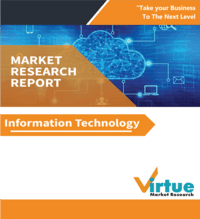Data Monetization Market Size (2025-2030)
The Data Monetization Market was valued at USD 5.2 billion and is projected to reach a market size of USD 8.4 billion by the end of 2030. Over the forecast period of 2025-2030, the market is projected to grow at a CAGR of 10.06%.
Data monetization is the deliberate process by which organizations put their data assets to use to create tangible economic value. This may include direct means, for example, selling data to other parties, or indirect means, for instance, using data to drive internal efficiencies, better customers, and strategic decision-making. Data monetization uses different approaches, including Data as a Service (DaaS), Insight as a Service (IaaS), analytics-enabled platforms, and embedded analytics. These approaches help businesses in various industries—like banking, retail, telecommunications, manufacturing, and healthcare—tap new revenue streams, achieve operational efficiency, and gain a competitive advantage in the marketplace. Yet, issues like data security, privacy, and regulatory compliance need to be addressed with caution to unlock the full potential of data monetization programs.
Key Market Insights:
- The world data monetization market is undergoing tremendous growth with the exponential growth in data creation across sectors and the strategic pivot towards using data as an invaluable asset. The market would be worth around USD 5.2 billion in 2025 and is anticipated to grow to USD 8.4 billion by 2030 at a Compound Annual Growth Rate (CAGR) of 18.6% for the forecast period. This growth is powered using sophisticated technologies like Artificial Intelligence (AI), Machine Learning (ML), and the Internet of Things (IoT), which allow organizations to drive action+able insights and new revenue streams from their data assets. Critical industries driving this movement are Banking, Financial Services, and Insurance (BFSI), retail, healthcare, and telecommunication, where data-based strategies improve customer experiences and operational efficiencies. However, data privacy issues and compliance are still essential considerations for companies that seek to effectively monetize their data.
Data Monetization Market Key Drivers:
Harnessing IoT and Digital Devices: The New Era of Data Generation
- Proliferation of Data Generation: The high adoption rate of digital devices and the Internet of Things (IoT) has resulted in an explosion in data generation. This boom offers organizations huge volumes of data that can be processed and sold for many different reasons.
- Technological Improvements in Data Analytics and AI: New analytical tools and AI technologies allow companies to extract meaningful insights from vast amounts of data. These improvements help enable the conversion of raw data into valuable resources, creating the need for data monetization solutions.
- Emergence of Digital Data Marketplaces: Digital data marketplaces have emerged as intermediaries to facilitate data transactions between data consumers and owners. These platforms ease data protection and logistics challenges associated with trading data, thereby opening data trading to be easily accessible and efficient.
Data Monetization Market Restraints and Challenges:
The market for data monetization is plagued by several major challenges and impediments. Among these are privacy concerns over data as well as logistics, which make data trading and monetization inefficient. Even though digital data marketplaces intended to enable transactions to have come into being, many firms fail to derive concrete value from their data resources, and thus they miss opportunities in customer understanding, pricing, and fraud prevention. Also, the constantly changing regulatory environment, as illustrated through efforts such as the antitrust probes in Europe into giant tech firms, further complicates data monetization endeavors, since firms must negotiate changing regulatory mandates to ensure they are in line. These combine to discourage easy monetization of data and warrant more study as well as strong frameworks for responding to such impediments.
Data Monetization Market Opportunities:
The market for data monetization is growing immensely, fueled by the mounting amount of data being generated across sectors and the growing need for actionable insights. With organizations realizing that data is an asset, they are developing different monetization methods, such as selling data, providing data-enabled products and services, and using analytics to improve internal processes. This trend is especially seen in industries like finance, healthcare, retail, and telecommunications, where data-driven decision-making is increasingly becoming part of business strategies. Advances in technology, such as the spread of Internet of Things (IoT) devices and the use of artificial intelligence (AI) and machine learning (ML) technologies, are also driving market growth by facilitating real-time data processing and advanced analytics capabilities. Nonetheless, challenges like data privacy issues, regulation, and effective data governance structures are still important considerations for organizations aiming to take advantage of data monetization possibilities.
DATA MONETIZATION MARKET REPORT COVERAGE:
|
REPORT METRIC |
DETAILS |
|
Market Size Available |
2024 - 2030 |
|
Base Year |
2024 |
|
Forecast Period |
2025 - 2030 |
|
CAGR |
10.06% |
|
Segments Covered |
By type of Data Monetization, Industry Vertical, Data Source, Deployment Model, Organization Size, and Region |
|
Various Analyses Covered |
Global, Regional & Country Level Analysis, Segment-Level Analysis, DROC, PESTLE Analysis, Porter’s Five Forces Analysis, Competitive Landscape, Analyst Overview on Investment Opportunities |
|
Regional Scope |
North America, Europe, APAC, Latin America, Middle East & Africa |
|
Key Companies Profiled |
Microsoft Corporation, Oracle Corporation, Salesforce.com, Inc., SAP SE, IBM Corporation, Accenture PLC, Infosys Limited, TIBCO Software Inc., Qlik Technologies Inc., Domo, Inc. |
Data Monetization Market Segmentation:
Data Monetization Market segmentation By type of Data Monetization:
- Internal Data Monetization
- External Data Monetization
In the area of data monetization approaches, analytics-as-a-service is expected to see major growth with real-time access to cloud-based data along with recurring triggers and alerts. This approach is expected to be an accelerator for various brands to help them become trailblazers in data-driven strategies and develop new streams of revenue. Although there is limited data on the relative growth rates of internal and external data monetization strategies, the general market trend shows strong growth across different monetization strategies. The rising amount of data creation, the evolution of analytics technologies, and the rising awareness of data as an asset are fueling this growth.
Data Monetization Market segmentation By Industry Vertical:
- Financial Services
- Healthcare
- Retail
- Telecommunications
The market for data monetization is seeing substantial growth across diverse industry segments, with the Banking, Financial Services, and Insurance (BFSI) segment leading the market share. This is because huge volumes of sensitive financial data are created, which can be utilized to better serve customers, handle risks, and improve operations. The BFSI industry's data monetization activities are centered around offering customized financial services, fraud detection and prevention, credit risk assessment, and compliance management. The large data assets coupled with the high demand for data analytics within the industry make it an ideal prospect for data monetization solutions.
Data Monetization Market segmentation By Data Source:
- Customer Data
- Operational Data
- Financial Data
- Sensor Data
Of all the different sources of data, customer data has the greatest market share due to its central role in allowing organizations to better understand and communicate with their customers. This is because there has been a growing demand for tailored marketing strategies and improved customer experience. Also, the finance sector will have the highest market size because financial reporting is an important aspect of organizations and plays a major role in shaping future business strategies for support, reducing costs, and proper control of the business environment.
Data Monetization Market segmentation By Deployment Model:
- On-Premises
- Cloud-Based
This expansion is fueled by the growing amount of data creation and the use of sophisticated analytics and visualization technologies. In terms of deployment models, cloud-based data monetization platforms are witnessing strong growth because they are scalable, flexible, and cost-saving. They do away with the requirement for huge initial investments in hardware and infrastructure, which makes them highly appealing to small and medium-sized businesses (SMEs). Cloud service's pay-as-you-go pricing helps companies grow data analytics resources based on usage to minimize cost and optimize utilization. Cloud deployment also makes it possible to easily access data and analytics tools anywhere, allowing distributed and remote teams to work seamlessly. This will persist, with cloud solutions taking a lion's share of growth in the market.
Data Monetization Market segmentation By Organization Size:
- Large Enterprises
- Small and Medium-Sized Enterprises (SMEs)
In the market of data monetization, big businesses are now at the top, with about 68% of the market share because they have vast data assets and huge investments in innovative technologies such as cloud computing and AI. Nonetheless, small and medium businesses (SMEs) are growing at the highest rate, with estimates showing a compound annual growth rate (CAGR) of more than 29% between 2025 and 2030. The increase in growth is due to the rising awareness of data value among SMEs, as well as their embracement of cloud-based platforms and data analytics solutions to improve business processes and decision-making.
Data Monetization Market Regional Analysis:
By 2024, the international data monetization market is anticipated to be valued at around USD 4.4 billion with North America alone contributing the biggest regional share of about 35%. This dominance can be due to the superior technological infrastructure available in the region, the region's early introduction to data monetization practices, and the concentration of many data providers. Europe will see high growth, with an estimated compound annual growth rate (CAGR) of 18.6% from 2025 to 2030 due to the growing uptake of data-driven decision-making methods in different sectors. The Asia-Pacific region will see the maximum CAGR at 19.0% driven by accelerated digitalization, enhanced investments in technologies, and the escalating significance of data analytics in new markets. Latin America and the Middle East & Africa will also be helping the market grow, though not as fast as the regions noted above.
COVID-19 Impact Analysis on the Data Monetization Market:
The COVID-19 pandemic has had a strong impact on the data monetization market, accelerating its growth and adoption in many industries. As remote work and digital interactions increased, organizations have come to value their data assets more, which has resulted in increased emphasis on data-driven decision-making and the use of sophisticated analytics solutions. This transformation has especially been noticeable across sectors like BFSI, wherein data usage has become key in improving customer experience and operations efficiency. Furthermore, the pandemic also highlighted the relevance of cloud technology, providing timely access and processing of data and hence fueling the growth of data monetization tools and solutions. However data privacy and security challenges have also been created, forcing organizations to implement stronger data governance models to help them comply with changing regulations.
Recent Trends/Developments:
The market for data monetization is growing at a rapid pace, fueled by technological innovation and the growing awareness of the value of data across sectors. The market is dominated by large businesses, which control about 68% of the market share because of their vast data assets and heavy investments in cutting-edge technologies such as cloud computing and artificial intelligence. But small and medium-sized enterprises (SMEs) are growing at the highest rate, with estimates putting their compound annual growth rate (CAGR) between 2025 and 2030 at more than 17%. The growth is because of the rising awareness of data value among SMEs and the implementation of cloud-based solutions and data analytics software to improve business operations and decision-making processes. The global data monetization market is expected to grow to USD 8.4 billion by 2030, with a CAGR of 18.6% over the forecast period. This is driven by the increasing amount of data produced by organizations, the necessity for data-driven decision-making, and improvements in data processing, storage, and analytics technologies. Furthermore, the convergence of advanced analytics and machine learning, the growth of Data as a Service (DaaS), and the focus on data security and privacy are important trends defining the market.
Key Players in the Data Monetization Market:
- Microsoft Corporation
- Oracle Corporation
- Salesforce.com, Inc.
- SAP SE
- IBM Corporation
- Accenture PLC
- Infosys Limited
- TIBCO Software Inc.
- Qlik Technologies Inc.
- Domo, Inc.
Chapter 1. Global Data Monetization Market– Scope & Methodology
1.1. Market Segmentation
1.2. Scope, Assumptions & Limitations
1.3. Research Methodology
1.4. Primary Sources
1.5. Secondary Sources
Chapter 2. Global Data Monetization Market – Executive Summary
2.1. Market Size & Forecast – (2024 – 2030) ($M/$Bn)
2.2. Key Trends & Insights
2.2.1. Demand Side
2.2.2. Supply Side
2.3. Attractive Investment Propositions
2.4. COVID-19 Impact Analysis
Chapter 3. Global Data Monetization Market– Competition Scenario
3.1. Market Share Analysis & Company Benchmarking
3.2. Competitive Strategy & Development Scenario
3.3. Competitive Pricing Analysis
3.4. Supplier-Distributor Analysis
Chapter 4. Global Data Monetization Market - Entry Scenario
4.1. Regulatory Scenario
4.2. Case Studies – Key Start-ups
4.3. Customer Analysis
4.4. PESTLE Analysis
4.5. Porters Five Force Model
4.5.1. Bargaining Power of Suppliers
4.5.2. Bargaining Powers of Customers
4.5.3. Threat of New Entrants
4.5.4. Rivalry among Existing Players
4.5.5. Threat of Substitutes
Chapter 5. Global Data Monetization Market- Landscape
5.1. Value Chain Analysis – Key Stakeholders Impact Analysis
5.2. Market Drivers
5.3. Market Restraints/Challenges
5.4. Market Opportunities
Chapter 6. Global Data Monetization Market – By Type of Data Monetization
6.1 Introduction/Key Findings
6.2 Internal Data Monetization
6.3 External Data Monetization
6.4 Y-O-Y Growth trend Analysis By Type of Data Monetization
6.5 Absolute $ Opportunity Analysis By Type of Data Monetization, 2023-2030
Chapter 7. Global Data Monetization Market – By Industry Vertical
7.1 Introduction/Key Findings
7.2 Financial Services
7.3 Healthcare
7.4 Retail
7.5 Telecommunications
7.6 Y-O-Y Growth trend Analysis By Industry Vertical
7.7 Absolute $ Opportunity Analysis By Industry Vertical , 2023-2030
Chapter 8. Global Data Monetization Market – By Data Source
8.1 Introduction/Key Findings
8.2 Customer Data
8.3 Operational Data
8.4 Financial Data
8.5 Sensor Data
8.6 Y-O-Y Growth trend Analysis Data Source
8.7 Absolute $ Opportunity Analysis Data Source , 2023-2030
Chapter 9. Global Data Monetization Market – By Deployment Model
9.1 Introduction/Key Findings
9.2 On-Premises
9.3 Cloud-Based
9.4 Y-O-Y Growth trend Analysis Deployment Model
9.5 Absolute $ Opportunity Analysis Deployment Model , 2023-2030
Chapter 10. Global Data Monetization Market – By Organization Size
10.1 Introduction/Key Findings
10.2 Large Enterprises
10.3 Small and Medium-Sized Enterprises (SMEs)
10.4 Y-O-Y Growth trend Analysis Organization Size
10.5 Absolute $ Opportunity Analysis Organization Size , 2023-2030
Chapter 11. Global Data Monetization Market, By Geography – Market Size, Forecast, Trends & Insights
11.1. North America
11.1.1. By Country
11.1.1.1. U.S.A.
11.1.1.2. Canada
11.1.1.3. Mexico
11.1.2. By Organization Size
11.1.3. By Deployment Model
11.1.4. By Data Source
11.1.5. Industry Vertical
11.1.6. Type of Data Monetization
11.1.7. Countries & Segments - Market Attractiveness Analysis
11.2. Europe
11.2.1. By Country
11.2.1.1. U.K.
11.2.1.2. Germany
11.2.1.3. France
11.2.1.4. Italy
11.2.1.5. Spain
11.2.1.6. Rest of Europe
11.2.2. By Organization Size
11.2.3. By Deployment Model
11.2.4. By Data Source
11.2.5. Industry Vertical
11.2.6. Type of Data Monetization
11.2.7. Countries & Segments - Market Attractiveness Analysis
11.3. Asia Pacific
11.3.1. By Country
11.3.1.2. China
11.3.1.2. Japan
11.3.1.3. South Korea
11.3.1.4. India
11.3.1.5. Australia & New Zealand
11.3.1.6. Rest of Asia-Pacific
11.3.2. By Organization Size
11.3.3. By Deployment Model
11.3.4. By Data Source
11.3.5. Industry Vertical
11.3.6. Type of Data Monetization
11.3.7. Countries & Segments - Market Attractiveness Analysis
11.4. South America
11.4.1. By Country
11.4.1.1. Brazil
11.4.1.2. Argentina
11.4.1.3. Colombia
11.4.1.4. Chile
11.4.1.5. Rest of South America
11.4.2. By Organization Size
11.4.3. By Deployment Model
11.4.4. By Data Source
11.4.5. Industry Vertical
11.4.6. Type of Data Monetization
11.4.7. Countries & Segments - Market Attractiveness Analysis
11.5. Middle East & Africa
11.5.1. By Country
11.5.1.1. United Arab Emirates (UAE)
11.5.1.2. Saudi Arabia
11.5.1.3. Qatar
11.5.1.4. Israel
11.5.1.5. South Africa
11.5.1.6. Nigeria
11.5.1.7. Kenya
11.5.1.11. Egypt
11.5.1.11. Rest of MEA
11.5.2. By Organization Size
11.5.3. By Deployment Model
11.5.4. By Data Source
11.5.5. Industry Vertical
11.5.6. Type of Data Monetization
11.5.7. Countries & Segments - Market Attractiveness Analysis
Chapter 12. Global Data Monetization Market – Company Profiles – (Overview, Product Portfolio, Financials, Strategies & Developments)
12.1 Microsoft Corporation
12.2 Oracle Corporation
12.3 Salesforce.com, Inc.
12.4 SAP SE
12.5 IBM Corporation
12.6 Accenture PLC
12.7 Infosys Limited
12.8 TIBCO Software Inc.
12.9 Qlik Technologies Inc.
12.10 Domo, Inc.
Download Sample
Choose License Type
2500
4250
5250
6900
Frequently Asked Questions
Data monetization refers to the process of converting data into economic value. This can involve selling raw data, offering data analytics services, or creating data-driven products.
Monetizing data offers several advantages for your business, such as diversified revenue streams, financial stability, encouraging innovation, establishing industry leadership, enhancing customer experiences, and providing a competitive edge in the market.
Start by identifying valuable data assets, ensuring data quality and compliance, choosing the right monetization strategy, investing in security and infrastructure, and measuring and optimizing performance
Common strategies include selling raw data, offering Data Analytics as a Service (DaaS), creating data-driven products, and collaborating with partners for joint efforts.
Key Performance Indicators (KPIs) help measure the effectiveness of data monetization efforts, tracking metrics such as revenue, customer satisfaction, and overall impact on business objectives.



